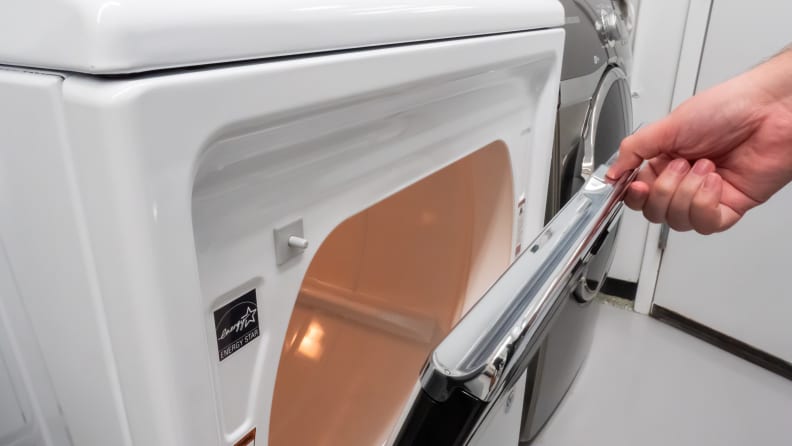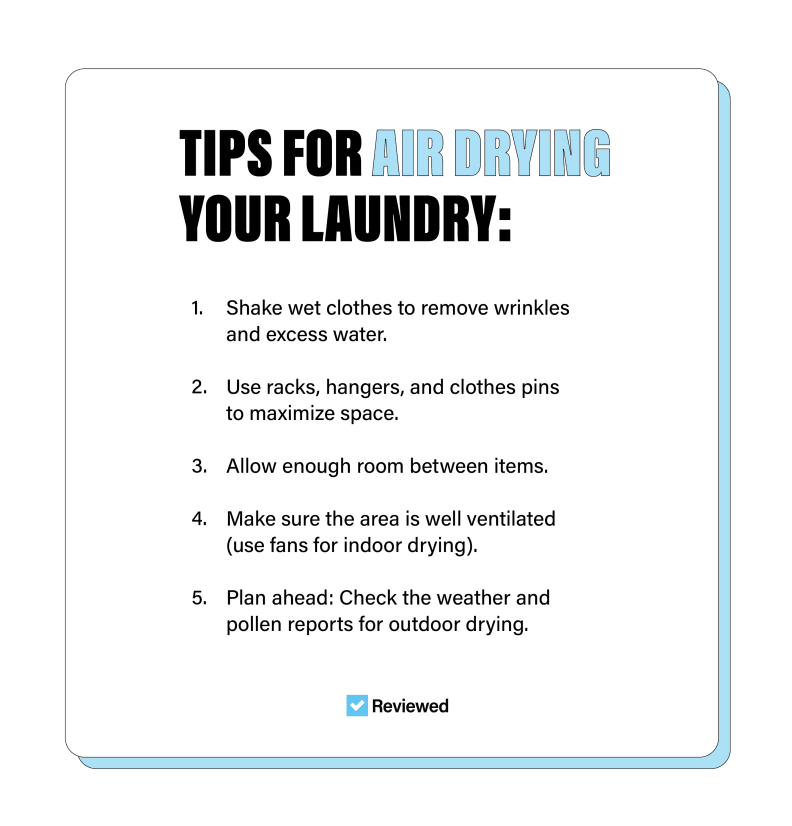Hit hard by inflation? This laundry hack may save you money
Experts weigh in on the pros and cons of air drying clothes
Products are chosen independently by our editors. Purchases made through our links may earn us a commission.
If your family is anything like mine, you do a lot of laundry. Our family of four does upwards of six loads a week—sometimes more. While having a dryer is convenient and fast, each load uses a fair amount of energy (and you may already be feeling the pinch on your latest billing statement). If you’re looking for ways to save money, one option to consider looking into is how to air dry clothes.
While a dryer certainly has its benefits, learning how to air dry clothes at home—indoors or out—may help lower the cost of your energy bill.
We spoke to several experts to find out if you can save money by air drying your clothes. Here’s what they had to say.
How much does a dryer cost to use?

An Energy Star certified dryer like the Maytag MED7230HW (pictured) can help cut down on laundry costs.
Dryers typically range from 24 to 72 cents per load, depending on the size and whether it's electric or gas-powered.
That doesn’t include the up-front cost of the appliance or any maintenance and repairs that might be required which, Phi Dang, director of home services company Sidepost, says should absolutely be factored into the cost consideration.
These energy and maintenance costs add up to hundreds of dollars per year for many families. If you have to use a coin-operated machine either at a laundromat or in your apartment complex, then that cost will be even higher.
If air drying your clothes is not an option, make sure to purchase an Energy Star-certified dryer. Appliances with this certification use less energy than their non-certified counterparts.
To keep your dryer working efficiently, make sure to clean to clean the vent and lint trap regularly. Additionally, drying similarly-weighted fabrics together and drying loads back-to-back (to make use of the residual heat) can help cut back on operating costs.
However, there is only so much optimization that can happen—using any appliance will cost money.
What to know about how to air dry clothes
The pros
Air and sunlight are free, and any time you don’t have to turn on the dryer, you save some money. But the benefits are much more than just cost savings. Air drying can be “gentler on your clothes and may help them last longer [than using a dryer],” Dang shares.
This is why clothing made from delicate fabrics is typically recommended to air dry. However, the high heat and tumbling from a dryer does damage even sturdier fabrics. In theory, the more wet laundry you hang out to dry, the less damage all of your clothing will take.
In addition to the pure monetary savings that come from air drying, you’ll also be reducing your carbon footprint. Even kilowatt-hour of electricity or therm of natural gas that you use is more energy generated and more carbon poured into the atmosphere.
The cons
The biggest drawback of air drying your clothes is the amount of time that it takes. Rather than simply tossing clothes into the dryer and hitting power, air drying requires carrying them outside and hanging them up individually.
You have to wait hours for them to be dry, with no way to speed up the process. Air drying is not a viable option for anyone who needs their favorite shirt to be ready to wear in an hour.
Air drying also takes up a lot of space. For many people, particularly those who live in apartments or homes with no yard, this is a deal breaker. While there are drying racks, where you can hang your clothes inside, these are not usually meant as replacements for dryers, but merely supplements for delicate clothes.
These space requirements also limit the amount of laundry that you can effectively do at one time. Depending on your setup, air drying may only allow you to finish one or two loads of laundry every day or two.
Finally, and this is a big one, drying your clothes outside subjects them to nature. Sometimes that’s part of the appeal, as the wind and sun are integral to drying.
However, nature also includes bugs, pine needles, pollen, rain, snow, and mud. There’s always the chance of any of these either preventing your clothes from drying or getting them dirty again.
In climates with cold weather, there will be significant portions of the year when drying clothes outside simply isn’t possible, so you need an indoor solution as a backup regardless.
Tips for how to air dry clothes

Make sure to allow plenty of space between wet items. If they are too close together, they won’t get enough airflow to wick away the moisture, leading to longer dry times.
If you’re drying outside, then chances are there is plenty of ventilation, but when drying inside, keep the air around the clothes moving. Turn on a fan or open the windows to increase airflow.
Poor ventilation in the drying area can result in excess moisture in the air, which can lead to mildew. Some people may want to even run a dehumidifier to cut down on this issue.
Air drying clothes is often weather dependent, and takes a long time even on warm, sunny, summer days. Keep an eye on the weather and when you’re going to need outfits, towels, or sheets. Nothing is going to make you quit air drying faster than never having the right outfit when you need it.
So, can you save money by air drying your clothes?
Yes, air drying will always be the cheapest option. Unfortunately, it's not for everyone, as you need the time and space to make it work well. If a dryer is your only option, you can still keep costs down.
Heat-pump models are the most energy-efficient but dry slowly and cost more up-front than vented dryers. If you need the speed and lower purchase price of a standard vented dryer, all is not lost, you can keep running costs low with an energy-efficient model.


